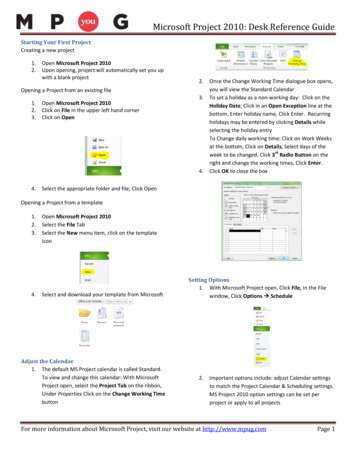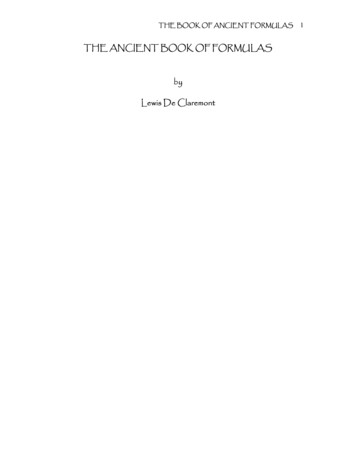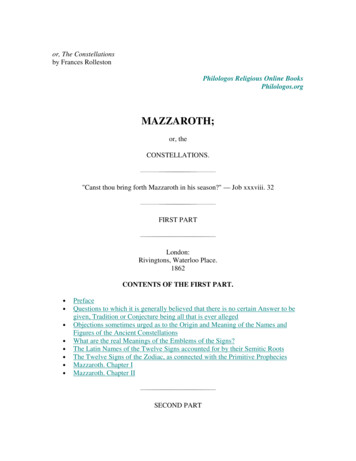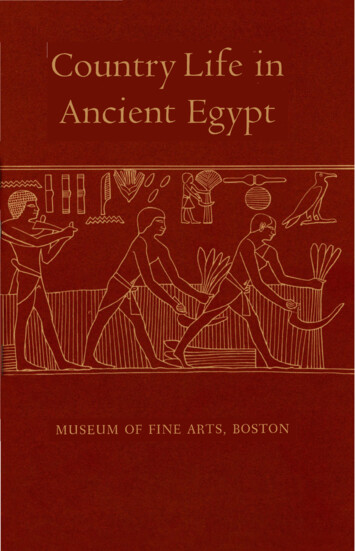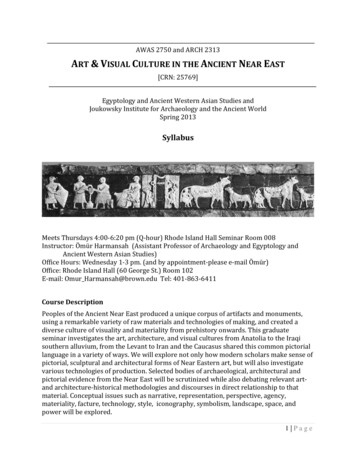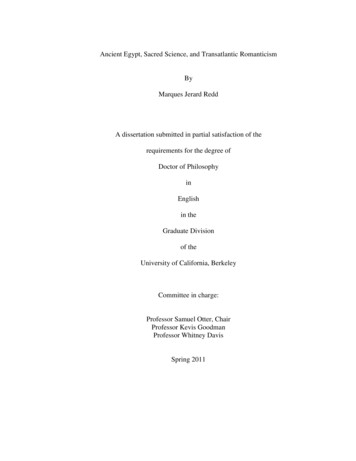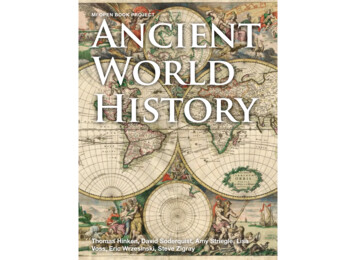
Transcription
MI OPEN BOOK PROJECTAncientWorldHistoryThomas Hinken, David Soderquist, Amy Striegle, LisaVoss, Eric Wrzesinski, Steve Zigray
The text of this book is licensed under a Creative CommonsNonCommercial-ShareAlike (CC-BY-NC-SA) license as part ofMichigan’s participation in the national #GoOpen movement.This is version 1.1.4 of this resource, released in August 2018.Information on the latest version and updates are available on theproject homepage: on-NonCommercial-ShareAlike CC BY-NC-SAi
The Michigan Open BookProjectAbout the Authors - Ancient World HistoryTom HinkenMontague Area Public SchoolsNellie B Chisholm Middle SchoolTom teaches world geography and history at NBC Middle School in Montague. A graduateof the Defense Language Institute, Tom served as an Arabic Linguist in the U.S Air Force before receiving both bachelors and masters degrees from Grand Valley State University. He iscurrently pursuing Masters in Education Technolofy from MSU. Along with teaching Tom isalso the advisor for the NBC Robotic club and the student leadership organization. Whenaway from school Tom and his wife Kristin love to travel and spend time outdoors; biking, hik-Project Manager: Dave Johnson,Wexford-Missaukee Intermediate SchoolDistrict7th Grade Team Editor - David Klemm,Muskegon Area Intermediate School DistrictAuthorsTom Hinken, Montague Area PublicSchoolsDavid Soderquist, Three Rivers PublicSchoolsDavid SoderquistThree Rivers Public SchoolsThree Rivers Middle SchoolFor the Past 11 years David has taught 6-8 grade Social Studies for Three RiversMiddle School. He serves as Department Head, School Improvement Member andSocial Studies Rep for his area. Over the past few years he has completed his Masters Degree in Curriculum and Instruction and become a state recognized Instructional Coach.Amy Striegle, Hamilton CommunitySchoolsLisa Voss, Holland Public SchoolsEric Wrzesinski, Pewamo-WestphaliaAmy StriegleHamilton Community SchoolsHamilton Middle SchoolAmy has been teaching 7th grade Social Studies and Economics at Hamilton MiddleSchool for 17 years. She has a BA in Geography/ Social Studies and a Masters Degree inMiddle School Education both from Western Michigan University. She is also a PASST assessment participant and the Social Studies Department Chair. When not in the classroom she enjoys traveling with her husband Dan.
Lisa VossHolland Public SchoolsEast K-7Lisa Voss has been teaching at Holland’s East K-7 since 1993 working with students ingrades 5-8. She enjoys teaching adolescents to be global thinkers in her geography andworld studies classes. Teaching in Holland has been fulfilling and challenging in so manyways for Mrs. Voss. She studied education and trained at Michigan State University andthen earned her masters degree at Grand Valley State University. She starting teachingelementary social studies content and methods to aspiring teachers for Hope College’sEducation Department in 2010. Lisa and her husband Jon have four sons and they live inZeeland.The Michigan Open Book ProjectTeam would like to thank thefollowing individuals for their helpin reviewing some content in thebook and guiding the developmentprocess.Eric Hemenway - Director ofRepatriation, Archives andEric WrzesinskiPewamo-Westphalia Community SchoolsPewamo-Westphalia Middle/High SchoolEric is a social studies teacher at Pewamo-Westphalia Middle/High School where heteaches 7th grade world history, 8th grade U.S. history, and AP U.S. History. He alsoserves as social studies department head, was a TRIG coach, worked on the schools strategic plan, and is a member of the school improvement team. He graduated with an undergraduate degree from Central Michigan University and grew up near Lansing, MI. Hecurrently resides in Portland, MI with his beautiful wife who he enjoys travelling and spending time with.Steve ZigrayConcord Community SchoolsConcord Middle SchoolSteve Zigray is a 6th grade teacher. He holds a Bachelor’s Degree from CentralMichigan University and a Masters Degree in K-12 Administration from EasternMichigan University. Honors Steve has been awarded are the 2001 Junior Achievement Educator of the Year and he was nominated for Jackson Magazine’s, Educator of the year in 2014. He has also coached high school and middle schoolsports, worked on various school improvement committees, wrote the 6th gradeCommon Assessment tests for Jackson County ISD and is an active member inthe community as well as the PTO. He lives in southeast Jackson County with hisRecords, Little Traverse Bay Bandsof Odawa IndiansJim Cameron, MichiganDepartment of Education
David KlemmEditorMuskegon Area Intermediate School DistrictDavid Klemm is the Social Studies and Special Projects Consultant for the Muskegon Area Intermediate School District (MAISD), serving 12 local school districts and numerous charters and privateschools. While spending most of his time with the Social Sciences, he also works with Art, Music,World Language and Physical Education teachers. He has successfully directed two TeachingAmerican History grants, coordinated We the People and Project Citizen programs, developed companion materials for the award-winning film documenting African-American migration to the Muskegon area, “Up from the Bottoms: The Search for the American Dream,” worked with communitydevelopment partners including the Michigan Humanities Council’s Prime Time Family Reading Program, made numerous state and national presentations and worked with individual schools andteachers on curriculum, instruction and assessment. Mr. Klemm is a charter member of the Boardof Directors of the Muskegon Center for Holocaust and Genocide Studies and currently serves onthe National Council for the Social Studies Board of Directors. Prior to his current position at theMuskegon Area ISD, Mr. Klemm taught high school U. S. History for 15 years and served 3 years asDavid A. JohnsonProject ManagerMichigan Open Book ProjectDave began his career teaching 8th grade United States History in Mesick, Michigan. Afteralmost a decade in the classroom, he took a job at Wexford-Missaukee Intermediate SchoolDistrict (WMISD) as an Instructional Consultant for Social Studies. He is shared across 11ISDs in Northern Michigan that form the Northern Michigan Learning Consortium. He completed his Masters in Educational Leadership through Central Michigan University in 2011and is Co-Project Director of the Performance Assessments of Social Studies Thinking(PASST) Project in addition to his duties as the Project Manager for MI Open Book.
Chapter 2What Factors andConditions Are MostSignificant for CreatingTimes of Innovation andGrowth?1. Why might humans want to move from an area?2. What might attract people to a new place?3. Why did humans start migrating out of Africa about 100,000years ago?4. What is meant by Paleolithic and Neolithic ways of life?5. How have Paleolithic and Neolithic patterns of life differedbetween the people of Africa Western Europe, Asia, and NorthAmerica?6. What benefits did early human farmers gain over hunter/gatherers?7. How did the natural environment affect the places early humanfarmers chose to live?8. What was the relationship between stable food supplies and thedevelopment of settlements?
Section 1Early MigrationsBefore we can begin to study the first peoples, it is important to establish theQUESTIONS TO GUIDE INQUIRY1. Why might humans want to move from an area?2. What might attract people to a new place?concept of time. Historians use timelines to help aid in the understanding of thetime frame in which the topic under study has taken place. The first step is toestablish how the past is organized into sections of time. The organization of timeinto Eras is a choice made by historians. The sections of time that are being used3. Why did humans start migrating out of Africa about100,000 ago?in this book are divided by major turning points (big events that change humans4. What is meant by Paleolithic and Neolithic ways of life?categories: Prehistory, Ancient History, Middle Ages, and Modern History. Below5. How have Paleolithic and Neolithic patterns of lifediffered between the people of Africa Western Europe,Asia, and North America?is a chart that breaks down the four Eras and major events that happened.forever) in history. This book is organizing the major Eras into the following four6. What benefits did early human farmers gain over hunter/gatherers?7. How did the natural environment affect the places earlyhuman farmers chose to live?8. What was the relationship between stable food suppliesand the development of settlements?TERMS, PLACES, PEOPLE:timelineprehistoryfossilsmigration26
We use timelines to help keep things in chronological order.Remember, history is like solving a mystery; and when youTimelines are a visual to help us "see" history so we can figurelearn new information, you need to make changes to yourout how long ago an event happened, make connectionsthinking. That has happened with the calendar, too. Morebetween events, and make comparisons between events.recent investigation would indicate that theRemember, how we organize time is a choice and even ourbirth of Christ actually took placecalendar reflects a choice; one made nearly 450 years ago. Theseveral years earlier than our calendarGregorian calendar is used in much of the Western world and iswould indicate. Even the leadingbased on the Christian religion. In other places around the world,Christian scholars think the Christiancalendars are written and time is measured differently.calendar is slightly off. Don’t worry; noIt is important for you to know that the labels used on ourtimelines are based on the Western Calendar.one will be changing the timeline. Ifthey did, you would have to changeyour birthdate!How do we know?Interactive 2.1 A Variety ofCalendarsInteractive 2.2 InteractiveTimelineInteractive 2.3 CalendarMiscalculationNow that you have a handle on how toread time the era this unit is going toRead more here: mine is Prehistory. This is a time of no written records whichmakes it really difficult to determine exactly what life was likethen. The evidence that is used by scientists,anthropologists, and historians are fossils and artifacts that havebeen discovered throughout the world. As you may recall fromchapter 1, fossils are the remains of living things (plants, animals,people). Artifacts are the remains of things that were made, notYou can read much more aboutdifferent calendars here: Use the pieces on this chart tocreate a timeline. Note: Thiscalendar has no year Zero and,though that non-existant yearrepresents the turning point in ourtimeline, it is not in the middle;there were many more years ofhistory before it, than after it (sofar!)the remains of living things. The weapons and tools left behindby a human are considered artifacts, while the bones of thathuman would be considered fossils.27
Fossils:Image source: ain/articles/ts LaBrana1 discovery feat free.jpgImage source: 5/Neolithic arrowheads Chariez.jpgArtifacts:Link to the PresentDid you know the arrowheads that are stillbeing found today in North America are actuallyStone Age artifacts?28
Prehistory is popularly referred to as the Stone Age because earlygrasslands or open forests is fairly easy. Travel is slower throughhumans used stone tools. Evidence suggests that these firstdense forests. High mountains are hard to climb and can be veryhumans hunted and gathered their food, lived in small groups,cold. Large deserts and oceans would be an even biggerlived in shelters, and used materials found in the environment.The oldest human fossils have been found in East Africaproblem. It is possible to walk fromAfrica all the way across Asia.suggesting that this is where the first humans lived. Why didUnfortunately, Asia is separated fromthese first humans leave Africa?Australia and the Americas by hugePrehistoric and Ancient MigrationUsing geological evidence, fossils, and artifacts, many scientistsbelieve that the earliest humans lived in Africa. From therehumans eventually started moving out or migrating. Humanmigration is the movement by people from one place to anotherwith the intentions of settling temporarily or permanently in thenew location. About a hundred thousand years ago, humansstarted to move from Africa to other parts of the world. It did nottake long to go from East Africa to nearby places like West Africaor Southwest Asia (see map on the next page) From there, theycould go on to Southern Europe or Central Asia. It took longer toget to Northern Europe, East Asia, and Australia. It took thelongest time to get to South America. People first had to crossbodies of water. Here, the story ofhuman migration was aided by anotherfact -- climate change.Today, the earth is fairly warm. Thereare only two large sheets of ice. One ofthese is on Greenland. The other is onAntarctica. Hundreds of highthem. These do not add up to even asmall fraction of the Greenland orago, the climate was much colder. Icesheets covered large parts of NorthAmerica and Eurasia. The earth has aentire length of both North and South America.more of it in the form of huge icesome places and hard in others. For example, moving throughInteractive 2.5 Land BridgeTheoryAntarctic icecaps. Thousands of yearslimited amount of water and with muchmany generations of people. Migration was relatively easy inFor more information on IceSheets visit: singseas-what-can-we-expect/mountains have small glaciers onfrom Asia to Alaska. Then they had to travel south through theThese are long distances, and it took a thousands of years andInteractive 2.4 Ice Sheetssheets, there was less in the ocean.As a result, the water level washundreds of feet lower than today. ThisWatch this short video to see thisin action: https://www.youtube.com/watch?v Ziw SmFKf g29
made it possible to walk on dry land from northeast Asia toresources (food, water, shelter),Alaska.fighting over resources resulting inPeople could also walk to many of the islands between Chinaand Australia. In other cases, people could see the land on theother side of a narrow area of water. That made it easier to makea boat and float across to the other side. People did that andarrived in Australia about 50,000 years ago. Then, about 13,000years ago, the climate began to get warmer. Glaciers melted andthe oceans rose. Eventually, areas that had been land werecovered by the oceans. The humans in the Americas and theislands of the South Pacific became isolated. Source: MichiganGeographic Alliance Phil Gersmehl 2015Interactive 2.6groups separating, and the theorythat humans simply went exploring.The factors that cause humans tomigrate are referred to as push andpull factors -- circumstances thatpush someone out of one regionand other circumstances that pullthem to another region.Practice: You can finish this mapby drawing arrows from olderdates to more recent ones. Theresult is a visual picture of humanmigration for the last 130,000years.Why would humansmigrate?The reasons for earlyhuman migrations is agreat mystery. There isevidence to suggest thatclimate changes mayhave caused the firstpeoples to move out ofAfrica. Other theoriesinclude: followingmigrating animals forfood, searching for more30
Humans still migrate today and we can understand that migrationbetter by thinking of the push/pull factors that are impactingthem.Interactive 2.7 VocabularyQuizletImage source: -2008What are the modern day push/pull factors for humanmigration? War, poverty, persecutions, environmentaleffects, adventure . How many of these might havemotivated ancient human migrations as well?Practice the vocabulary from thissection with this interactivewidget.31
Section 2What Do Archaeologists Know and How do theyKnow It?QUESTIONS TO GUIDE INQUIRYAs you read in the previous section, the first Era of history is called Prehistory and1. Why might humans want to move from anarea?takes place before the written language was invented. So how do historians know2. What might attract people to a new place?3. Why did humans start migrating out ofAfrica about 100,000 years ago?what happened if there are no records? Scientists use fossils and artifacts foundto help piece together what life was like during this time. The map below givessome examples of evidence that has been discovered around the world.4. What is meant by Paleolithic and Neolithicways of life?5. How have Paleolithic and Neolithic patternsof life differed between the people of AfricaWestern Europe, Asia, and North America?6. What benefits did early human farmers gainover hunter/gatherers?7. How did the natural environment affect theplaces early human farmers chose to live?8. What was the relationship between stablefood supplies and the development ofsettlements?TERMS, PLACES, PEOPLE:artifactsImage source: The World of Rock Art: its distribution around the globe32
The importance and significance ofthis heritage can also be seen inInteractive 2.8 RockPaintingshigh in the mountains along the border between Austria and Italy.He is the Europe’s oldest natural mummy. Scientists even gave him athe following list of the rock artnickname: Otzi the Iceman. Otzi was an important scientific findsites included on UNESCO’s list ofbecause according to the South Tyrol Museum of Archaeology inworld heritage. Today, there areItaly, where Iceman can be seen,people dedicated to preserving this“The Iceman is one of the oldest mummies in the world. However,ancient art so that all people canit is not only his historical age that makes him particularlyshare in a part of their commonhistory. You can see about theirwork and view some of these rockpaintings in the widget (Interactivevaluable for scientists but also the way in which he was mummified.You can learn about their workand view some of these rockpaintings here . http://www.prehistour.eu/2.8).Ötzi is a so-called 'wet mummy', i.e. one in which humidity isretained in individual cells. The body tissue is elastic and suitablefor performing detailedscientific investigations. Moreover, he isa natural mummy, unaltered by burialIt is because of this evidence thatscientists believe the first peoplesInteractive 2.9 How StuffWorks - Carbon Datingbegan in East Africa-- because theInteractive 2.10 IcemanParody Videorites or other interventions. The Icemanwith his complete clothing andequipment provides a snapshot ofStone Age life in Europe” (2013).oldest human fossils have beendiscovered there. Anthropologistsdetermine the age of a fossil usinga process called carbon dating.One of the greatest human fossildiscoveries was the Iceman whichLearn more here!we used as an example in the firstchapter. The Iceman had been preserved in a glacier since around3300 BC. He was discovered by hikers in 1991 CE in Europe,33
Other great clues to prehistory arein the form of art. Artifacts foundInteractive 2.11 AnalyzingArtifactsare often sculptures, jewelry,Link to the presentmasks, and drawings. Go to thisWhat happens when new artifacts and fossils are found thatsite (Interactive 2.11) and see howdisrupt current theories? Remember in chapter 1 howwell you can analyze the maskhistorians need to be flexible and rethink their theories whenartifact. What questions might younew discoveries are made? Check this out.ask that will help you?Cave Art has also been used tohelp understand life duringprehistoric times as well. The mapbelow shows several sites whereCave Art has been discovered. GoGo to this site and see how wellyou can analyze the mask artifact.What questions might you ask thatwill help you?Interactive 2.13 TheChanging Human StoryInteractive 2.12 Cave Art Bradshaw Foundationto the following site (Interactive2.12) to see real examples. Useyour questioning skills to thinkdeeply about what you see.Well it’s back to the drawing boardwe have new pieces and will haveto rethink our puzzle. Prehistory willalways be a mystery!Go to the following site to see realexamples. Use your questioningskills to think deeply about whatyou see.Scientists have discovered a newspecies of human ancestors deepin a South African cave, adding abaffling new branch to the familytree.34
Section 3Environmental Effects on First HumansQUESTIONS TO GUIDE INQUIRYDuring the Prehistoric Era there were multiple climate changes. One type of1. Why might humans want to move from anarea?change is called the Ice Age which is a period of extreme cold. Scientists believe2. What might attract people to a new place?3. Why did humans start migrating out ofAfrica about 100,000 years ago?4. What is meant by Paleolithic and Neolithicways of life?5. How have Paleolithic and Neolithic patternsof life differed between the people of AfricaWestern Europe, Asia, and North America?6. What benefits did early human farmers gainover hunter/gatherers?7. How did the natural environment affect theplaces early human farmers chose to live?8. What was the relationship between stablefood supplies and the development ofsettlements?that there were five great Ice Ages with the most recent one ending around 10,000years ago. During this particular Ice Age, the northern polar icecap moved so farsouth that most of North America was covered by ice, including all of Michigan.About 30 percent of the earth was covered in ice! Naturally, hunting and gatheringwas difficult during the Ice Ages. The first people hadto adapt to their surroundings. Therefore thesehunters and gatherers had very differentInteractive 2.14 What is anIce Ageenvironmental conditions to deal with. Life in the coldclimates would have hunters and gatherers usinganimal hides to keep warm and hunting animals thatwere more suitable to live in cold climates, such asthe Woolly Mammoth. This video will give you a littlemore explanation about why ice ages happen.Learn more about an Ice Age inthis video.TERMS, PLACES, PEOPLE:ice age35
Areas that were not covered in ice were still affected by thecold temperatures and would have determined the migrationpatterns of early animals and humans. Here is an example:During the time when sea level was low due to the ice buildupin the Northern Hemisphere, many of today’s islands wereconnected to continents. New Guinea and Tasmania were partof “super-Australia.” Three large islands of Indonesia –Sumatra, Java, and Borneo -- were connected to Asia. Usingthese “land bridges,” animals and plants could move fromcontinent to island and back. When the ice sheets melted, sealevel went up. Different islands ended up with different plantsand animals: Borneo has tigers and gorillas. These animalsImage source: https://commons.wikimedia.org/wiki/File:Mammoth House (Replica).JPGalso live in Vietnam, India, and other countries of South andSoutheast Asia. New Guinea has kangaroos and opossums.These animals also live in Australia.Image source: https://simple.wikipedia.org/wiki/Woolly mammothSource: Michigan Geographic Alliance Phil Gersmehl 201536
Sulawesi has many strange animals. Nearly twothirds of its mammals are found nowhere else inthe world. This is because Sulawesi was notconnected to either Asia or Australia. Many birds inSulawesi, by contrast, are also seen in both Asiaand Australia. Why? Because birds can fly.Crossing a little bit of ocean is no big deal.Australia is dry and far from other land. As a result,many of its plants are different from plants in othercontinents. Nearly all of the trees in Australia, forexample, are in just one family -- the Eucalyptusfamily. Because Australia had a warmer climateduring the Ice Ages, their environment affectedthem differently. They would have hunted animalsthat suited a warmer climate and their shelterswould have been made from different materialsImage source: https://en.wikipedia.org/wiki/Indigenous architecturethan the Northern Hemispheric hunters andgatherers.37
Section 4Who Were The First Peoples?QUESTIONS TO GUIDE INQUIRYThe Prehistory Period was broken into the Paleolithic (Old Stone Age) and the1. Why might humans want to move from anarea?Neolithic (New Stone Age). This period of time is called the Stone Age because2. What might attract people to a new place?3. Why did humans start migrating out ofAfrica about 100,000 years ago?most of the tools used by these first peoples were made of stone. During thePaleolithic time period, the early humans used these simple tools made from stone,and others made from animal bone, and ivory, to hunt, skin, and butcher animals.These first tools were also used to dig up roots, cut through wood and bones, and4. What is meant by Paleolithic and Neolithicways of life?5. How have Paleolithic and Neolithic patternsof life differed between the people of AfricaWestern Europe, Asia, and North America?6. What benefits did early human farmers gainover hunter/gatherers?7. How did the natural environment affect theplaces early human farmers chose to live?8. What was the relationship between stablefood supplies and the development ofsettlements?TERMS, PLACES, PEOPLE:PaleolithicNeolithicNomadic38Ax: Paleolithic hand axes. Image. Encyclopædia Britannica. Web. 15 Jun. 2016. 4B23F18E.jpg .
as weapons. These tools have been found all over the world, butthe oldest have been found in East Africa. It is important to notethat this time period has different starting points because regionsaround the world started the technology of making tools atdifferent times. This shouldn’t be surprising; we have already seenhow animal and plant life developed differently in different places.The first Paleolithic people hunted their food and gatheredberries, nuts, and other plants from the environment. Many ofthese first people also found their food supplies by fishing. Thesefirst peoples were nomadic -- moving from place to place findingfood, water, and shelters. These nomadic groups were often verysmall due to a lack of a stable food supply and the need toconstantly be on the move to survive. So how did we get towhere we are today? It started with getting a stable food supply!39
Section 5The First Farmers and Agricultural RevolutionQUESTIONS TO GUIDE INQUIRYThe Paleolithic Era ended when humans invented farming. Again, like the1. Why might humans want to move from anarea?development of tools, this happened at different times in different places. Up to2. What might attract people to a new place?this point humans would hunt and gather their food. So why did some humansstop? Why would our ancestors decide to settle inone place and invent farming? Many scientists believe3. Why did humans start migrating out ofAfrica about 100,000 years ago?that the climate began to warm up and this change in4. What is meant by Paleolithic and Neolithicways of life?With this climate change, plants began to flourish.5. How have Paleolithic and Neolithic patternsof life differed between the people of AfricaWestern Europe, Asia, and North America?6. What benefits did early human farmers gainover hunter/gatherers?climate made the discovery of growing plants simple.People no longer needed to wander for food. Withthis invention of farming, humans could now start tosettle in one place and stop needing their nomadiclifestyle. They had, as the following video states,“everything they needed in one place.”7. How did the natural environment affect theplaces early human farmers chose to live?The process of planting seed and harvesting crops8. What was the relationship between stablefood supplies and the development ofsettlements?called the Agricultural Revolution and begins theTERMS, PLACES, PEOPLE:agricultureInteractive 2.15 FromHunters and Gatherers toFarmersis called agriculture. This turning point in History isNeolithic or New Stone Age.With this invention of farminghumans could now start to settlein one place and stop neededtheir nomadic lifestyle. They had,as the following video state,“everything they needed in oneplace.”The switch from hunting and gathering to farming didnot happen all at once in all areas of the world, so some historians will refer to thistransition period as the Mesolithic or Middle Stone Age. During the Agriculturaldomesticateirrigation40
It is important to note that even though the word fertile infers thatthis area was full of great farmland, that was hardly the case. Thisland was mostly arid (dry) and had rocky soil. So how did itbecome the first agricultural center? Because of the rivers thatoften flooded. Southwest Asia has a short rainy season in winter.Fortunately, some snow falls on the mountains. It melted andmade rivers flood in the spring. The extra water spread over anylow land close to the river.To most modern people, floods are bad. In ancient times,however, floods in many places were considered good becausethey were predictable; that is, they occurred at the same timesevery year and people could learn just how high the water wouldrise. Over time, a flooding river makes a floodplain by depositingmud on low land near the river. Even more importantly, floodsmake the soil softer and much easier to work. Floods also fill theground with water. People can get this water later by diggingwells. All of this can help subsistence farmers (people who growfood just for themselves).Image source: https://c2.staticflickr.com/6/5100/5512116621 c14bc2762c b.jpgRevolution (Neolithic Age) many changes took place. The biggestchanges include: the settling of people into villages, invention ofbetter tools, domestication of plants and animals, and theinvention of irrigation. Archaeological evidence suggests that thevery first farming began in a region of Southwest Asia called the“Fertile Crescent.” See map above.If people settle in one place,
teaches 7th grade world history, 8th grade U.S. history, and AP U.S. History. He also serves as social studies department head, was a TRIG coach, worked on the schools stra-tegic plan, and is a member of the school improvement team. He graduated with an un-dergraduate degree from Cen
